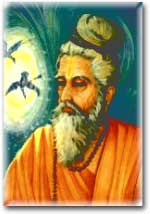Today is Valmiki Jayanti (October 7th., 2006).
From here
The birthday of the Ai Kavi (the first poet), Valmiki is celebrated on the full moon day of Ashvina (September - October). Valmiki is the author of the so-celebrated Ramayana in Sanskrit. He was contemporary of Rama, the hero of the Ramayana. Valmiki himself represented as taking part in some of these scenes he relates. He received the banished Sita into his hermitage and educated her twin sons Kusha and lava. The invention of the "Shioka" (epic meter) is attributed to Valmiki.Originally, Valmiki belonged to a depressed class and was a sort of robber. He robbed and even killed the people passing through the forest, but because of the influence of some sages, he repented and betook himself to a hermitage on a hill in the district of Bonda in Bundelkhanda. There, he is said to have eventually received Sita, when banished by Rama.He got his name "Valmiki" because when immersed in meditation, he allowed himself to be overrun with ants like an anthill. His original name was "Ratnakar". Many depressed classes in the country trace their lineage to Valmiki. On his birthday he is worshipped and prayed and his portraits are taken out in processions through the and streets. Kirtans are also held in Valmiki temples.
From here
The story of Valmiki is steeped in legend. One version has it that Valmiki was originally a dalit dacoit called Ratna who haunted the forests and preyed upon the unwary travellers. One day a sage called Narada passed through the forest. Ratna saw him and immediately attacked him. Narada asked him why he did his foul deeds to which Ratna replied that it was to take care of his family, which consisted of his aged parents, wife and children. The sage then wanted to know if they would be willing to share in the punishment for his misdeeds. Ratna was sure they would but the sage advised him to go and ask them. Ratna tied the sage to a tree and ran home to ask his family if they would share in his punishments. His family replied in the negative, saying that it was Ratna's duty to take care of them and they were not responsible for the path he chose to do so. Disappointed, Ratna returned to the forest and confessed to the sage. The sage told him to repent for his sins and to stop his evil ways and to chant the name of Lord Rama. Legend has it that Valmiki meditated in one place till an ant-hill formed on top of him without him realising it. Hence the name Valmiki (from 'Valmik' which means ant-hill in Sanskrit). Valmiki became a maharishi (great sage).
There is another legend behind his writing the Ramayana. According to this legend, Valmiki was in the forest one day, when a hunter shot a bird. Valmiki was so touched by the pain of the bird that he composed and sang a sad song. Brahma was greatly moved by the touching song. He appeared before Valmiki and asked him to compose the life of Sri Rama in a similar verse. This is how maharishi valmiki started to write Ramayana
Brahma gave the gift of insight of Sri Rama's life to Valmiki. Valmiki began to compose the great eternal song and poem of the life of Sri Rama—The Ramayana. Valmiki's Ramayana is the very first poem in Sanskrit. Therefore, it is called the Adikavya or "The first poem" and Valmiki is also known as the Adikavi, which means "The first poet".
Legend has it that it was Maharshi Valmiki who offered refuge to Sita the wife of Lord Rama, and the queen of Ayodhya when she was banished from the kingdom. It was in his hermitage in the forest that Rama and Sita's twin sons Lava and Kusha were born and brought up.
Maharishi Valmik is accepted by many Indian communities as the author of the Yoga Vasistha, this particular piece of work was taught to Rama when he was disillusioned with the world in large . The Yoga Vasistha is an incredible piece of text which discusses a wide array of philosophical issues. Moreover, it appears to have been written over 5000 years ago
There is another legend behind his writing the Ramayana. According to this legend, Valmiki was in the forest one day, when a hunter shot a bird. Valmiki was so touched by the pain of the bird that he composed and sang a sad song. Brahma was greatly moved by the touching song. He appeared before Valmiki and asked him to compose the life of Sri Rama in a similar verse. This is how maharishi valmiki started to write Ramayana
Brahma gave the gift of insight of Sri Rama's life to Valmiki. Valmiki began to compose the great eternal song and poem of the life of Sri Rama—The Ramayana. Valmiki's Ramayana is the very first poem in Sanskrit. Therefore, it is called the Adikavya or "The first poem" and Valmiki is also known as the Adikavi, which means "The first poet".
Legend has it that it was Maharshi Valmiki who offered refuge to Sita the wife of Lord Rama, and the queen of Ayodhya when she was banished from the kingdom. It was in his hermitage in the forest that Rama and Sita's twin sons Lava and Kusha were born and brought up.
Maharishi Valmik is accepted by many Indian communities as the author of the Yoga Vasistha, this particular piece of work was taught to Rama when he was disillusioned with the world in large . The Yoga Vasistha is an incredible piece of text which discusses a wide array of philosophical issues. Moreover, it appears to have been written over 5000 years ago


No comments:
Post a Comment